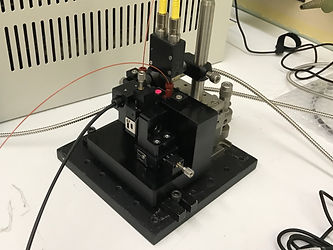Research
Our Raman probes and systems have been used worldwide to conduct innovative research. This includes applications like analyzing analytes in nuclear fuel reprocessing schemes and microfluidics.
Nuclear Fuel Reprocessing Process Monitoring
Raman and UV-vis-NIR absorption are analytical techniques that can be used for the analysis of key analytes (actinides and nitrates) in nuclear fuel reprocessing schemes. Raman can be used to detect U(VI), HNO3, and NO3- in various aqueous and organic streams. Pu species can be determined by visible absorption spectroscopy using multiple absorption bands. Np species are monitored by visible and NIR spectroscopy. Figure 1 contains a series of Raman and UV-vis NIR spectra of fuel reprocessing solutions demonstrating the detection and linear response for uranium, plutonium and neptunium.

Figure 1. Raman Spectra of UO2(NO3)2 (left), UV-vis-NIR spectra of Pu(IV) (center) and Np(V) (right) in nuclear fuel reprocessing feed simulant solutions. Inset plots are linear response of Raman and UV-vis-NIR bands as a function of analyte concentration.
Publications:
Amanda M. Lines,* Susan R. Adami, Sergey I. Sinkov, Gregg J. Lumetta, and Samuel A. Bryan,
"Multivariate Analysis for Quantification of Plutonium(IV) in Nitric Acid Based on Absorption Spectra," Anal. Chem. 2017, 89, 9354−9359.
Amanda M. Lines,* Susan R. Adami, Amanda J. Casella, Sergey I. Sinkov, Gregg J. Lumetta, and Samuel A. Bryan, "Electrochemistry and Spectroelectrochemistry of the Pu (III/IV) and (IV/VI) Couples in Nitric Acid Systems," Electroanalysis 2017, 29, 2744 – 2751.
Monitoring for Process Control using Visible, Near-Infrared, and Raman Spectroscopy
This study demonstrates the use of sensor fusion, combining visible, near-infrared (NIR), and Raman spectroscopy, for real-time, on-line monitoring of complex nuclear fuel reprocessing streams. The study focuses on quantifying key analytes like plutonium (Pu), uranium (U), neptunium (Np), and nitric acid (HNO₃) in highly challenging environments. Raman spectroscopy plays a critical role in this multimodal approach, particularly for identifying and quantifying species such as U(VI) and HNO₃, which exhibit distinct Raman fingerprints (Figure 3). The technique's ability to provide molecular-specific information, even in the presence of overlapping spectral features from other components, makes it indispensable for accurate real-time analysis.

Figure 2. Sensor fusion design: schematic of a flow cell combining absorbance (UV−vis and NIR) and Raman spectroscopy to monitor a process stream for multiple analytes.

Figure 2 in practice, with Raman probe provided by Spectra Solutions Inc.
Publication:
Amanda M. Lines, Gabriel B. Hall, Susan Asmussen, Jarrod Allred, Sergey Sinkov, Forrest Heller, Neal Gallagher, Gregg J. Lumetta, and Samuel A. Bryan, "Sensor Fusion: Comprehensive Real-Time, On-Line Monitoring for Process Control via Visible, Near-Infrared, and Raman Spectroscopy," ACS Sensors 2020 5 (8), 2467-2475
Microfluidics


Set ups used in these studies, provided by Spectra Solutions
Microfluidics has emerged as a transformative technology for chemical processing, offering precise control over reactions while minimizing waste and enhancing safety—particularly in hazardous applications like nuclear fuel reprocessing. A critical advancement in this field is the integration of micro-Raman spectroscopy, which enables real-time, in situ monitoring of chemical species within microfluidic channels. The development of specialized Raman probes with micron-scale resolution allows researchers to interrogate small volumes with high accuracy, overcoming traditional limitations of bulk analysis. These systems are especially valuable for studying complex mixtures, where overlapping spectral bands or interfering species would otherwise complicate quantification.
Publications:
Amanda M. Lines, Gilbert L. Nelson, Amanda J. Casella, Job M. Bello, Sue B. Clark, and Samuel A. Bryan, "Multivariate Analysis To Quantify Species in the Presence of Direct Interferents: Micro-Raman Analysis of HNO3 in Microfluidic Devices," Analytical Chemistry 2018 90 (4), 2548-2554
Gilbert L. Nelson, Amanda M. Lines, Amanda J. Casella, Job M. Bello and Samuel A. Bryan, "Development and testing of a novel micro-Raman probe and application of calibration method for the quantitative analysis of microfluidic nitric acid streams," Analyst, 2018, 143, 1188
Gilbert L. Nelson, Susan E. Asmussen, Amanda M. Lines, Amanda J. Casella, Danny R. Bottenus, Sue B. Clark, and Samuel A. Bryan, "Micro-Raman Technology to Interrogate Two-Phase Extraction on a Microfluidic Device," Analytical Chemistry 2018 90 (14), 8345-8353
Gilbert L. Nelson, Hope E. Lackey, Job M. Bello, Heather M. Felmy, Hannah B. Bryan, Fabrice Lamadie, Samuel A. Bryan, and Amanda M. Lines, "Enabling Microscale Processing: Combined Raman and Absorbance Spectroscopy for Microfluidic On-Line Monitoring," Analytical Chemistry 2021 93 (3), 1643-1651
